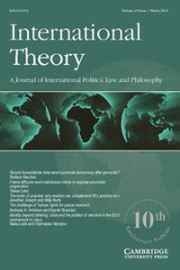By Lenz, Tobias

Why have many regional organizations adopted common markets and customs unions? This article proposes a cognitive diffusion mechanism – termed frame diffusion – to explain convergent institutional choices across structurally diverse settings. Using Strang and Meyer’s (1993) notion of ‘theorization’ to combine foundational work on framing with the literature on diffusion, I argue that processes of theorization transform the experience of successful institutional innovators into abstract cognitive schemas, which link a particular understanding of a cooperation problem to specific institutional solutions. As policymakers in other contexts encounter similar cooperation problems, they adopt framed institutional solutions, which results in institutional convergence at the macro level. I further suggest that this process of frame diffusion is conditional on ideational affinities in social purpose between the innovating organization and other regional organizations. Where other organizations pursue a distinct social purpose, policymakers rely on alternative frames and thereby cement institutional variation. After developing this argument theoretically, I illustrate it in an exploratory comparison of institutional choice in three most different regional organizations: Association of Southeast Asian Nations, Common Market of the South, and the Southern African Development Community. The argument points to significant ‘blind spots’ and conceptual complementarity between prominent mechanisms of diffusion.

» An earlier version of this article was published as a working paper entitled “Frame Diffusion: How European Union-type Common Markets Have Spread Around the World” in the Max Weber Programme Working Paper Series of the European University Institute (No. 2016/06). Access here.
Published:
2018